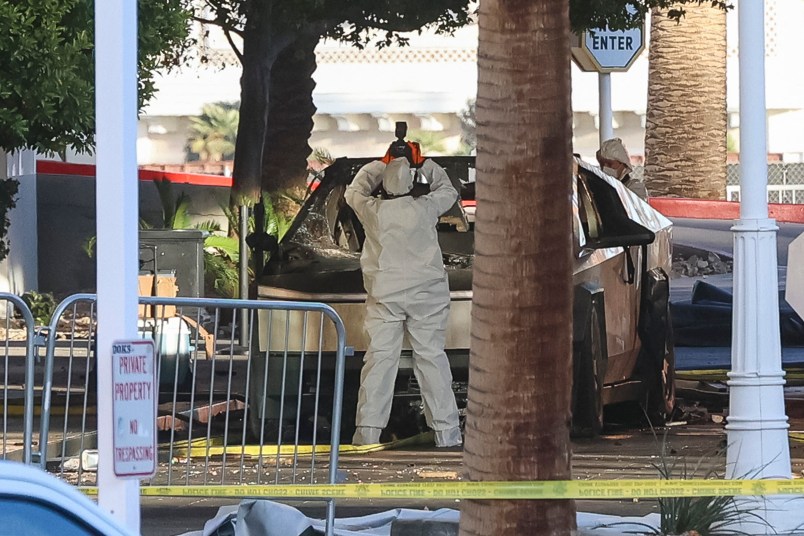For years there’s been a running conversation in the United States about whether the country is heading towards a second Civil War. That conversation often stumbles on the fact that America’s profound divides today don’t line up on any clear regional lines, despite what the maps of presidential election results might seem to show. Divisions are at best intra-regional. So any kind of replay of the 1860s is highly unlikely. But of course plenty of civil wars either had no clear regional breakdown or at least don’t start with one — the Spanish Civil War, the Russian Civil War, the Chinese Civil War, the Syrian Civil War. Before going further I should note that as a general matter I’m a “no” on this question of “are we headed to a second American civil war?” But events yesterday and those of last month suggest the possibility of something more realistic and still ominous.
Let’s quickly review the details: yesterday in New Orleans we had what appears to be an ISIS-inspired lone wolf terrorist attack. The FBI is now discounting initial suspicions that others might be involved. Events like these happened with some frequency in the U.S. for a number of years. But there’s been some respite, more or less since the Pandemic. Then a Tesla Cybertruck exploded in front of a Trump building in Las Vegas. The driver was killed and the car appeared to be filled with high-powered fireworks and gas canisters. It’s still not clear what this incident was about. That’s not remotely how you’d build a car bomb if you wanted to injure anyone. But it certainly doesn’t seem like an accident either.
The latest information about the Cybertruck explosion is that the driver and apparent culprit was a 37-year-old active-duty member of the U.S. Army, Matthew Livelsberger. Investigators are now reviewing very tenuous evidence of a possible connection between what happened in New Orleans and Las Vegas. What’s being reported at least is that both vehicles were rented from the same company and both men served at the same time at what was then called Fort Bragg. Those seem like pretty tenuous connections. (Fort Bragg, now named Fort Liberty is a massive complex.) But they could be the first hints of some cooperation between the two men. I’m going to assume for the purposes of this post that they are not connected. But the jury is still out.
Then lets go back to December 4th, when Luigi Mangione shot and killed the CEO of United Healthcare. In the background in recent months there have been a number of arrests of groups or individuals the government believed or feared were planning attacks of various sorts. Just yesterday a court filing revealed that in December the FBI found what it claimed was the biggest collection of homemade explosive devices in the Bureau’s history at a home outside Norfolk, Virginia. The government was not able or hasn’t yet been able to point to any evidence of a plan to use the devices. But the court filing suggests hostility toward President Biden and Democrats.
Aside from a conceivable connection between the New Orleans and Las Vegas cases yesterday, these different incidents not only don’t seem connected in the sense of some joint conspiracy. They also run the gamut ideologically — more or less recognizable cases of lone wolf Islamist terrorism in New Orleans and a right-wing dude building an arsenal in Virginia. With Mangione, a highly privileged kid goes off the rails and commits what used to be known as “propaganda of the deed” targeting the U.S. health care system. At this point, it’s a true Rorschach trying to make sense of just what the plan or point may have been with the Cybertruck explosion. And then there were the two assassination attempts on Donald Trump. The first seemed to follow the general trajectory of a school shooting or mass shooting until veering off into targeting Trump; the second had a culprit with a scattering of political enthusiasms but who generally seemed to be aligned as hostile to Trumpism. And we shouldn’t ignore the example right in front of our faces, a generation of young, angry men and boys who shoot up their schools before often taking their own lives. Sometimes these guys leave a trail of semi-articulate indicators of political motivation — they hate women or Blacks or Jews. Usually the “cause” is the violence itself.
But perhaps that very cacophony is the story: a lot of angry people, angry at different things, but all simultaneously resorting to or planning violence of one kind or another. There are pretty real precedents for this. We often color it over with a weird kind of willed amnesia. But America has always been a pretty violent place. And not just in the sense of having murder rates substantially higher than Europe or other economically advanced industrial democracies. We’ve also always had a lot of political violence. Indeed, the era after the U.S. Civil War had endemic political and politics-adjacent violence at a particularly high level.
Let’s start with the fact that the winners of the 1860, 1880 and 1900 elections were all murdered by assassins. That’s a lot! There was also widespread paramilitary violence across the American South over the same period. Lynchings and Klan violence of course continued in the South right up through the 1960s. But the two weren’t the same. 20th century organized violence against African-Americans in the American South was largely about reinforcing and policing a system the White South had won through paramilitary violence in the 20 to 30 years after the Civil War. The original Klan wasn’t just lynchings and people operating semi in the shadows, albeit with the sufferance of public authorities. It operated as a full-scale paramilitary. Then there was all the violence surrounding labor unrest. There was also quite a lot of bombings of various sorts, some adjacent to labor activism but often of a more general anarchist character. McKinley’s assassin was an anarchist whose path to radicalism appeared to start with his own loss of employment during the Panic of 1893.
Quite simply, the late 19th century was a particularly violent period in American history, and particularly violent both within and adjacent to the political process. It wasn’t like the 1960s or the 1990s or the teens of this century when there was politically inflected violence that was overwhelmingly on the left or the right. It was more like everyone was more violent at once — a general disinhibition affecting all “sides,” with incidents feeding on each other. It doesn’t take too great an imagination to see the U.S. today moving in a similar direction. I’m not placing any great weight on the events of the last four or five weeks to make this argument. But I think this may be the best framework to understand them.
Two final observations.
First, it may not be a coincidence that today and the late 19th century were both periods of spiraling economic inequality and declining trust in established institutions. They are both periods of high immigration, though the differences on that front are many.
Second, political violence is a curious and seductive thing. People routinely see aspects of intention and even valor in political violence notionally aimed at values they agree with, even when they don’t condone the violence itself. We can see this in the fanboying (and girling) around Luigi Mangione. And we can see it around the Jan 6th instigators. (No, I don’t think they’re comparable. You don’t see prominent elected officials cheering on Mangione.) My point here isn’t one of trying to figure out whose violence might be more justifiable. It’s that in cases of violence in the service of goals we might feel broadly aligned with we generally tend to see the violence in more linear and literal terms. The culprit believed very deeply in X or Y and was finally driven to violence because traditional means didn’t work. But it’s not necessarily like that. The train of causation and ideation can run in the opposite direction. You’re motivated toward violence and then you find an ideological framework into which to fit your hunger for violence.
It’s this more general disinhibition that seems most relevant, a greater social hunger for violence that is worth taking stock of prior to the point it actualizes itself through one political narrative or another.
In any case, be safe out there. It’s dangerous a place.


 Member Newsletter
Member Newsletter
